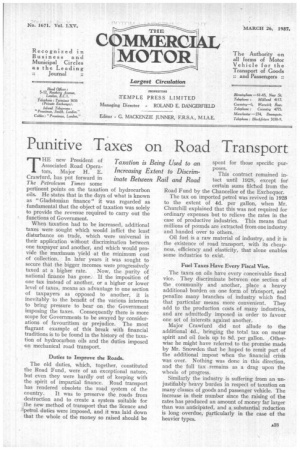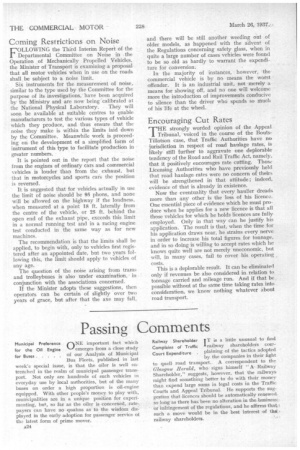Punitive Taxes on Road Transport
Page 25

Page 26

If you've noticed an error in this article please click here to report it so we can fix it.
THE new President of Associated Road Operators, Major H. E. Crawfurd, has put forward in The Petroleum Times some pertinent points on the taxation of hydrocarbon oils. He states that in the days of what is known as " Gladstonian finance" it was regarded as fundamental that the object of taxation was solely to provide the revenue required to carry out the functions of Government.
When taxation had to be increased, additional taxes were sought which would inflict the least disturbance on trade, which were universal in their application without discrimination between one taxpayer and another, and which would provide the maximum yield at the minimum cost of collection. In later years it was sought to secure that the bigger incomes were progressively taxed at a higher rate. Now, the purity of national finance has gone. If the imposition of one tax instead of another, or a higher or lower level of taxes, means an advantage to one section of taxpayers as opposed to another, it is inevitably to the benefit of the various interests to bring pressure to bear on the Government imposing the taxes. Consequently there is more scope for Governments to be swayed by considerations of favouritism or prejudice. The most flagrant example of this break with financial traditions is to be found in the history of the taxation of hydrocarbon oils and the duties imposed on mechanical road transport.
inate Between
Duties to Improve the Roads.
The old duties, which, together, constituted the Road Fund, were of an exceptional nature, but even they were hardly out of keeping with the spirit of impartial finance. Road transport has rendered obsolete the road system of the country. It was to preserve the roads from destruction and to create a system suitable for the new method of transport that the licence and 'Ipetrol duties were imposed, and it was laid down that the whole of the money so raised should be spent for those specific purposes.
This contract remained intact until 1928, except for certain sums filched from the Road Fund by the Chancellor of the Exchequer.
The tax on imported petrol was revived in 1928 to the extent of 4d. per gallon, when Mr.
Churchill explained that this was not required for ordinary expenses but to relieve the rates in the case of productive industries. This means that millions of pounds are extracted from one industry and handed over to others.
Oil fuel is a raw material of industry, and it is the existence of road transport, with its cheapness, efficiency and elasticity, that alone enables some industries to exist.
Rail and Road
Fuel Taxes Have Every Fiscal Vice.
The taxes on oils have every conceivable fiscal vice. They discriminate between one section of the community and another, place a heavy additional burden on one form of tlansport, and penalize many branches of industry which find that particular means more convenient. They add to the production costs of many industries, and are admittedly imposed in order to favour one set of intereSts against another.
Major Crawfurd did not allude to the additional 4d., bringing the total tax on motor spirit and oil fuels up to 8d. per gallon. Otherwise he might have referred to the promise made by Mr. Snowden that he hoped to remit part of the additional impost when the financial crisis was over. Nothing was done in this direction, and the full tax remains as a drag upon the wheels of progress.
Similarly the industry is suffering from an un justifiably heavy burden in respect of taxation on many classes of goods and passenger vehicle. The increase in their number since the raising of the rates has produced an amount of money far larger than was anticipated, and a substantial reduction is long overdue, particularly in the case of the heavier types.
Coming Restrictions on Noise
FOLLOWING the Third Interim Report of the Departmental Committee on Noise in the Operation of Mechanically Propelled Vehicles, the Minister of Transport is examining a proposal that all motor vehicles when in use on the roads shall be subject to a noise limit.
Six instruments for the measurement of noise, similar to the type used by the Committee for the purpose of its investigations, have been acquired by the Ministry and are now being -calibrated at the National Physical Laboratory. They will soon be available at suitable centres to enable manufacturers to test the various types of vehicle which they produce, and thus ensure that the noise they make is within the limits laid down by the Committee. Meanwhile work is proceeding on the development of a simplified form of instrument of this type to facilitate production in greater numbers.
It is pointed out in the report that the noise from the engines of ordinary cars and commercial vehicles is louder than from the exhaust, hut that in motorcycles and sports cars the position is reversed.
It is suggested that for vehicles actually in use the limit of noise should be 95 phons, and none will be allowed on the highway if the loudness, when measured at a point 18 ft. laterally from the centre of the vehicle, or 25 ft. behind the open end of the exhaust pipe, exceeds this limit in a normal running test and in a racing engine test conducted in the same way as for new machines.
The recommendation is that the limits shall be applied, to begin with, only to vehicles first registered after an appointed date, but two years following this, the limit should apply to vehicles of any age.
The question of the noise arising from trams and trolleybuses is also Under examination, in conjunction with the associations concerned.
If the Minister adopts these suggestions, then operators can be certain of slightly over two years of grace, but after that the axe may fall, and there will be still another weeding ottt of older models, as happened with the advent of the Regulations concerning safety glass, when in quite a large number of cases vehicles were found to be so old as hardly to warrant the expenditure for conversion.
In the majority of instances, however, the commercial vehicle is by no means the worst offender. It is an industrial unit, not merely a means for showing off, and no one will welcome more the introduction of improvements conducive to silence than the driver who spends so much of his life at the wheel.
Encouraging Cut Rates
THE strongly worded opinion of the Appeal Tribunal, voiced in the course of the BoutsTillotson case, that Traffic Authorities have no jurisdiction in respect of road haulage rates, is likely still further to aggravate one deplorable tendency of the Road and Rail Traffic Act, namely, that it positively encourages rate cutting. Those Licensing Authorities who have previously held that road haulage rates were no concern of theirs will be strengthened in that attitude ; indeed, evidence of that is already in existence.
Now the eventuality that every haulier dreads more than any other is the loss of his licene. One essential piece of evidence which he must produce when he applies for a new licence is that all those vehicles for which be holds licences are fully employed. Only in that way can he justify his application. The result is that, when the time for his application draws near, he strains every nerve in order to increase his total figures for tonnage, and in so doing is willing to accept rates which he knows quite well are not merely uneconomic, but • will, in many cases, fail to cover his operating costs.
This is a deplorable result. It can be eliminated only if revenues be also considered in relation to tonnage carried and mileage run. And if that be possible without at the same time taking rates into consideration, we know nothing whatever about road transport.




















































































